After eight days of weather delays we finally flew to the South Pole!
Click the "Media" to see a YouTube video of the trip!
This day started much like most of the previous eight. I woke up at 0545 to be prepared to fly to the South Pole. By 0700 the flight was delayed for 10 hours due to weather. Then at 1730, after reporting to "transport" a two-hour maintenance delay was added. That pushed our "Transport" time until 1930 that evening. Rumors were rampant that we were going to be "scrubbed" or worse yet...that we would Boomerang when we got near "Pole." We knew that the flight was important and valuable because there were a bunch of people who had been stuck at "Pole" who were supposed to "Fly North" off of the continent. And many of us, including an NSF Representative needed to get to Pole because we all had work to accomplish!
How do you get to the South Pole?
Normally people fly to the South Pole. Some people make a 40-day, 995-mile trip, driving giant tracked machines pulling sleds loaded with fuel and equipment called a "Traverse." We flew on a U.S. Air Force LC-130 for the 3-hour trip.
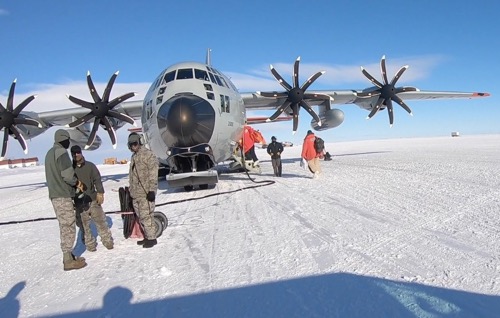 This LC 130 took 2018 PolarTREC teacher Mike Penn to the South Pole.
This LC 130 took 2018 PolarTREC teacher Mike Penn to the South Pole.
The C-130 is slow, cold, loud and uncomfortable.
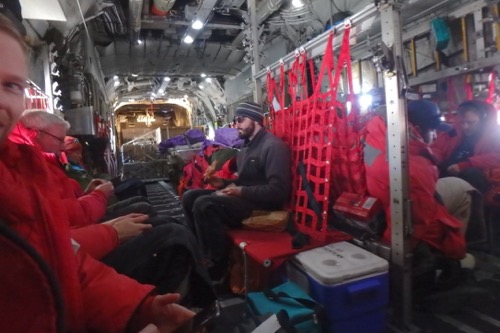 The C-130 was not built for comfort. It was designed to be a durable airplane that could cary large amounts of cargo or troops. It can land and take off on relatively short runways in challenging conditions.
The C-130 was not built for comfort. It was designed to be a durable airplane that could cary large amounts of cargo or troops. It can land and take off on relatively short runways in challenging conditions.
But it can carry a lot of things and can land on short and rough ice runways in less than perfect conditions. That makes it perfect for this trip. When we landed, the LC-130 didn't shut down the engines. As we were walking into the South Pole Station there were people walking out to board the plane to go back to McMurdo Station. The weather window was closing (the weather was getting bad again) and they couldn't afford to stop for very long. The plane was gone again in less than 30 minutes.
South Pole
The latitude and longitude of the South Pole is just "90˚ South" latitude. There is not normally a longitude given because...which one would you choose? All of the lines of longitude converge at the South Pole so the longitude could be...any one of them for 0˚ to 359˚ (any one of them would indicate the same spot on the Earth, so it is just omitted. The only other place on Earth where that is also true is the North Pole, which is 90˚ North latitude. Interesting Right?
As we walked in we were very close to the Geographic South Pole, that point where all of the lines of longitude converge on a single spot.
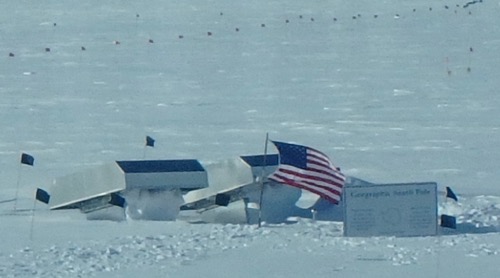 The Geographic South Pole, that point on Earth where all of the lines of longitude converge on a single point.
The Geographic South Pole, that point on Earth where all of the lines of longitude converge on a single point.
So when we walked in from the plane to the station steps we had walked in 12 different time zones! We could also see the "Ceremonial Pole" not too far away. That was where the Geographic South Pole had been when the new station was built a few years ago.
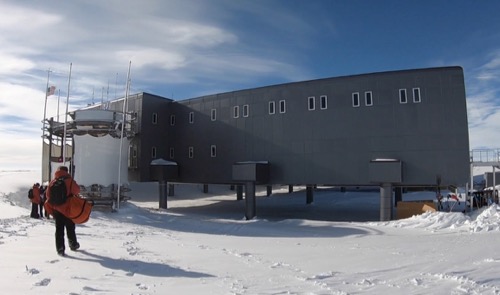 Even though it is just past midnight, since it is the Austral Summer the South Pole station at 90˚ South Latitude, experiences 24 hours of daylight.
Even though it is just past midnight, since it is the Austral Summer the South Pole station at 90˚ South Latitude, experiences 24 hours of daylight.
The geographic pole needs to be moved every year because the ice sheet that the station is sitting on is slowly sliding (it is a 9300-foot deep glacier) to the east at about 30 feet a year. By the way, these pictures were taken when we arrived at the South Pole. It was about midnight. So for those of you who think I'm joking about the 24 hours of daylight inside the Antarctic Circle...I'm not, it is a real thing!
A prize for those of you who actually read this entire journal.
I saw one penguin a few days ago!
My friends and I went over to the New Zealand "Scott Base" almost two miles from McMurdo for their weekly "America Night." While we were there we noticed that there was one single penguin near the pressure ridges. I took a few pictures, but since it was so far away I assumed that I couldn't see the penguin. I was mostly correct, the penguin is difficult to see in the picture, but, trust me, there is a penguin there!
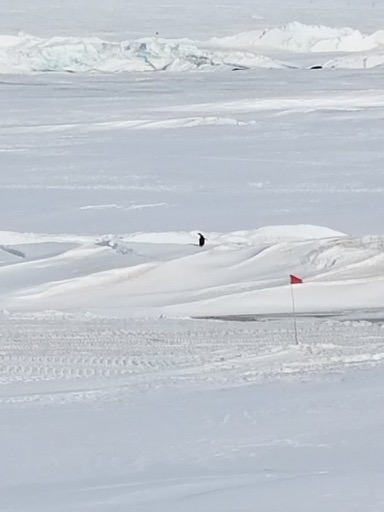 If you look very closely and use your imagination you can see the one penguin that I've sen here in Antarctica. This penguin was seen near the pressure ridges below Scott Base.
If you look very closely and use your imagination you can see the one penguin that I've sen here in Antarctica. This penguin was seen near the pressure ridges below Scott Base.

Comments
Add new comment